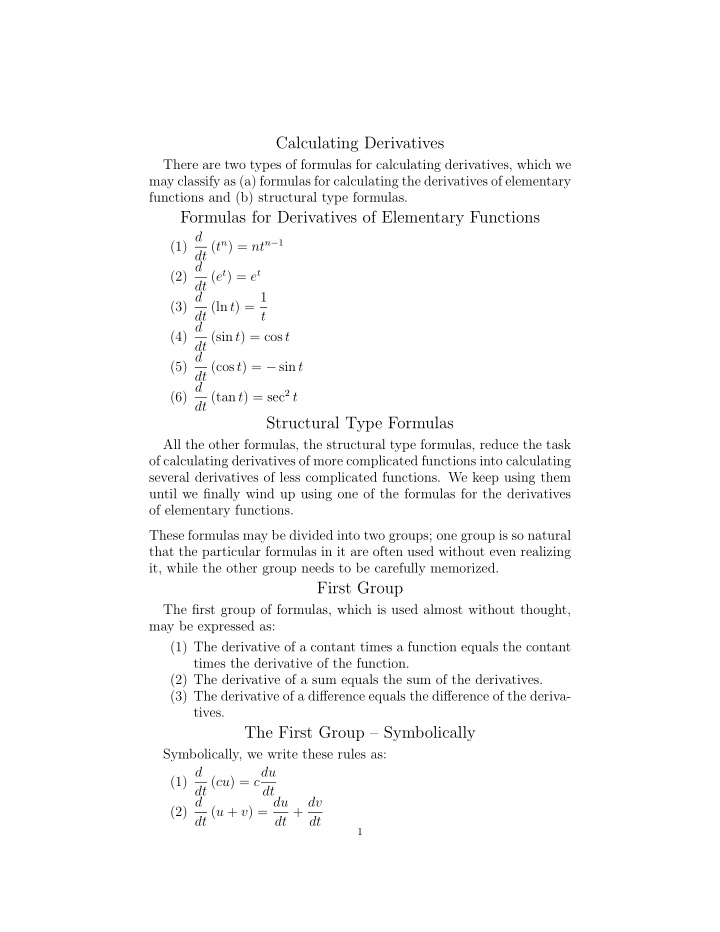



Calculating Derivatives There are two types of formulas for calculating derivatives, which we may classify as (a) formulas for calculating the derivatives of elementary functions and (b) structural type formulas. Formulas for Derivatives of Elementary Functions (1) d dt ( t n ) = nt n − 1 (2) d dt ( e t ) = e t (3) d dt (ln t ) = 1 t (4) d dt (sin t ) = cos t (5) d dt (cos t ) = − sin t (6) d dt (tan t ) = sec 2 t Structural Type Formulas All the other formulas, the structural type formulas, reduce the task of calculating derivatives of more complicated functions into calculating several derivatives of less complicated functions. We keep using them until we finally wind up using one of the formulas for the derivatives of elementary functions. These formulas may be divided into two groups; one group is so natural that the particular formulas in it are often used without even realizing it, while the other group needs to be carefully memorized. First Group The first group of formulas, which is used almost without thought, may be expressed as: (1) The derivative of a contant times a function equals the contant times the derivative of the function. (2) The derivative of a sum equals the sum of the derivatives. (3) The derivative of a difference equals the difference of the deriva- tives. The First Group – Symbolically Symbolically, we write these rules as: (1) d dt ( cu ) = cdu dt (2) d dt ( u + v ) = du dt + dv dt 1
2 (3) d dt ( u − v ) = du dt − dv dt . When we apply these rules, we say that we are differentiating “term by term”. Special Cases Using these rules along with the power rule, it is very easy to differ- entiate any polynomial. Some special cases such as the following come up so often that we tend to take them for granted and use them as nonchalantly as we use the power rule: (1) dc dt = 0 (2) d dt ( ct ) = c (3) d dt ( at + b ) = a The Second Group The last three rules are somewhat more difficult. They are called the product rule, the quotient rule and the chain rule. Of these, the product and quotient rules can be used routinely, since it is easy to recognize when you have a product or quotient, but it is more difficult and takes more practice to use the chain rule correctly. The Product and Quotient Rules in Words The product rule may be thought of as the derivative of a product equals the first factor times the derivative of the second plus the second factor times the derivative of the first . The quotient rule may be thought of as the derivative of a quotient equals the denominator times the derivative of the numerator minus the numerator times the derivative of the denominator, all divided by the square of the denominator . The Product and Quotient Rules – Symbolically Symbolically, we express these rules as follows: Formula 1 (Product Rule) . d dt ( uv ) = udv dt + vdu dt Formula 2 (Quotient Rule) . vdu dt − udv d dt dt ( u/v ) = v 2
3 The Chain Rule The chain rule is a little trickier to use. Fortunately, its formula is easier to remember than some of the others. Formula 3 (Chain Rule) . dy dx = dy du · du dx The chain rule is used for calculating the derivatives of composite functions. The easiest way to recognize that you are dealing with a composite function is by the process of elimination: if none of the other rules apply, then you have a composite function. Overall Strategy (1) Differentiate term by term. Deal with each term separately and, for each term, recognize any constant factor. (2) For each term, recognize whether it is one of the elementary functions (power, trigonometric, exponential or natural loga- rithm of the independent variable). If it is, you can easily apply the appropriate formula and you will be done. If it’s not, go on to (3). (3) Decide whether the term is a product or a quotient. If it is, use the appropriate formula. Note that the appropriate formula will have you calculating two other derivatives and you will have to go back to (1) to deal with those. If it isn’t, go to (4). (4) If you’ve gotten this far, you have to use the Chain Rule. Try to use it correctly. The note attached to (3) applies here as well.
Recommend
More recommend